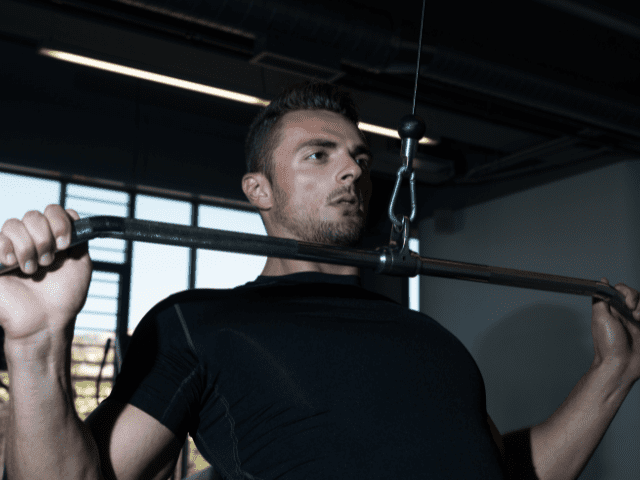Chin-Ups (How To, Muscles Worked, Benefits)
One of the most basic but also probably one of the most important exercises a person can master is the chin-up. Chin-ups are basically Pull-Ups twin brother, separated only be a different grip on the bar.
In this guide, I will be going over how to do a proper Chin-up, coaching points, common mistakes, and some variations, alternatives, and modifications if you happen to need them.
How To Do Chin-Ups
Equipment Needed
- Pull Up Bar (Either as part of a rack or a wall-mounted bar)
- Weight belt (For weighted variations)
- For modification purposes:
- Resistance Band (To assist in completing the pull-up or doing more repetitions with full range of motion).
- Partner (To assist in getting your chin over the bar)
Step-by-Step Instruction
- Approach the pull-up bar and grab the bar with a supinated grip (palms facing toward you).
- Use a bench to get to the bar if it is too high.
- Squeeze the bar and engage the core muscles and do not cross your legs.
- Engage the upper back and pull up until your chin is over the bar.
- Pause for 1 second with your chin over the bar.
- Slowly lower yourself back to the starting position.
- Repeat until all reps are completed.
Coaching Points
Take your time and master the chin-up. The benefits of doing sound chin-ups will pay dividends for your shoulder health and the potential to maximize your upper body strength.
I would highly recommend this movement to any lifter or athlete. It provides all the benefits of an upper-body pulling movement with little to no risk.
Common Mistakes
By far the biggest mistake I see in the chin-up is lifters not using a full range of motion. Hang all the way down and maintain great tension through the shoulders and abdomen (DO NOT JUST HANG IN THE BOTTOM). Pull all the way up and do not whip your head so that your chin barely makes it over the bar.
As with any exercise, do not sacrifice form for the sake of trying to add weight for weighted chin-ups.
Another mistake is lifters going too fast with their chin-ups. Pull-ups are commonly programmed for strength and hypertrophy. This means time under tension is key. Take them slow and perfect the movement to yield maximal results.
Muscles Worked
Chin-ups work the back and put a strong emphasis on the biceps because of the supinated shoulder-width grip. The abs also come into play to help stabilize the body.
- Lats
- Upper back
- Biceps
- Abdominal and lower back muscles (Stabilizers in almost all movements)
Chin Up Modifications
For many, chin-ups are an advanced movement. Few people can just start doing 5 or more perfect chin-ups. (Emphasis on the word perfect).
Here are some modifications to the chin-up that will help you progress and achieve successful full-range motion chin-ups with patience and persistence.
Band Assisted Pull-Ups
Loop a band to the top of the lifting rack or pull-up bar. Place your knee or foot in the band. Execute the chin-up with perfect form. Use a band that allows you to complete 3-8 pull-ups with perfect form. If you can do more than 8 with this band, use a thinner band.
As you progress with your band-assisted, always consider doing chin-ups without assistance. Track your progress and push yourself to perform those chin-ups without help.
Partner Assisted Concentric Followed by Eccentric Chin-Up
Have a partner assist you in reaching the top of the chin-up repetition. Then slowly lower yourself down to the start.
This is a great variation for novice lifters who need to focus on time under tension, improve grip and core strength, and develop those posterior chain muscles that we know need to be strong.
Isometric Chin-Up Holds

Get to the top of the rep by jumping up or have a partner assist you. Then hold an isometric position with your chin over the bar.
Do not rest your chin on the bar. Squeeze that position as hard as you can. The duration of the rep should be programmed and progressed based on athlete readiness.
Chin-Up Variations
The chin-up has some great variations that can be utilized based on athletic readiness, training needs, and sport specificity.
Weighted Chin-Ups
Grab your weight belt and overload your chin-ups. Weighted chin-ups are one of the best variations a lifter can make to their training programs. Once regular pull-ups are perfected, progressive overload must be challenged.
I would highly recommend this lift for any lifter who is ready to challenge their upper body strength.
Tempo Chin-Ups
Tempo Chin-ups refers to controlling the tempo, or speed, of the eccentric, concentric portions of the lift as well as the how long to hold the full contraction.
For example, a 1-3-3 tempo would be a 1 second concentric. This basically means pulling yourself straight up to the bar.
The second number, 3, is how long to pause with the chin over the bar. The final number, also 3, means it should take 3 seconds to slowly lower yourself back to the starting position.
Controlling the tempo controls the amount of time under tension. More time under tension makes the chin-ups more difficult but will also help with building mass.
Chin-Up Alternatives
If a lifter is not ready for pull-ups, don’t worry. There are tons of movements that train the upper body for pulling.
Inverted Rows
Inverted Rows are another bodyweight back exercise that is not to be underestimated.
Set your barbell at bench press height. Take a pronated or supinated grip based on your needs. Extend your legs, engages the core, and pull yourself up the bar. Lock in the reps and slowly lower yourself back down. This is a fantastic movement for lifters to develop those posterior chain muscles.
Not only are they a great progression to get you on the path to being able to do pull-ups, but Inverted Rows would also be my recommended substitution if you have a rack but no pull-up bar.
Lat Pulldowns

I do not often recommend machines but in this case, the Lat Pull-downs are worth mentioning. If a lifter has a lower-body injury, the lat pull-down is a great option for continuing training while the lower half is being rehabilitated.
This is also a great option for novice and veteran lifters looking to add extra volume at the end of a session.
More Info and Links
Looking for some more great exercises to increase your upper body strength? Head over to our exercise library to find step-by-step exercises to help you get stronger. All for free.

